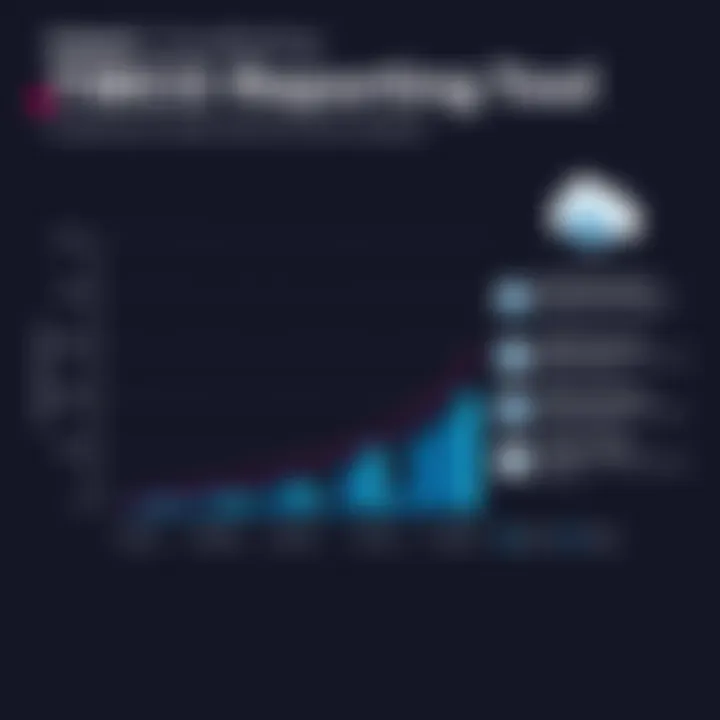Comprehensive Analysis of the TIBCO Reporting Tool


Intro
Data-driven decision-making is now more than just a trend; it's a necessity in today's fast-paced business environment. Among the myriad tools available, the TIBCO Reporting Tool stands as a notable contender. This software is designed not only to simplify data visualization but also to enhance the way businesses understand and act upon their insights.
The relevance of the TIBCO Reporting Tool extends beyond mere aesthetics of data. It plays a crucial role in how organizations translate raw data into actionable strategies. This exploration will dissect the multifaceted features of TIBCO's offering, while also looking into real user experiences and some common hurdles that professionals face while using it.
In this article, professionals in IT, software development, and business management will find insights tailored to their needs. By delving into its various functionalities and applications, we aim to provide a roadmap for harnessing this tool effectively.
Software Overview
Software Features
The TIBCO Reporting Tool is packed with features that cater to both technical users and business stakeholders. It provides:
- Advanced Data Visualization: Transform your data into interactive visual formats, making it easier to grasp complex findings.
- Integration Capabilities: Seamlessly connects with databases like Oracle, SQL Server, and even cloud platforms such as AWS and Google Cloud.
- Custom Reporting: Users can tailor reports to suit specific business needs, eliminating irrelevant data clutter.
- Mobile Accessibility: With responsive design, reports can be accessed on various devices, enhancing decision-making on the go.
These features underscore TIBCO's commitment to not just provide data, but to also enable users to interpret and leverage it effectively.
Technical Specifications
From a technical standpoint, TIBCO's offering is designed to be robust yet straightforward. Here are some noteworthy specifications:
- Language Support: The tool supports multiple programming and scripting languages, allowing flexibility for developers.
- Performance Metrics: Users often report improved performance thanks to optimized querying and rendering processes.
- Security Features: With built-in security protocols, sensitive information remains safe, aligning with industry standards.
In its entirety, the technical framework supports a wide range of organizational needs, from small-scale operations to large enterprises.
Peer Insights
User Experiences
User feedback often paints a vivid picture of the tool's real-world application. Many professionals cite the TIBCO Reporting Tool as a critical asset, especially in environments where data is abundant. Users appreciate:
- Ease of Use: Even those without a deep technical background can quickly get accustomed to its interface.
- Supportive Community: The presence of forums and discussions, such as those on platforms like Reddit, allows users to share tips and strategies, enhancing collective knowledge.
Nonetheless, while experiences may vary, many users find that the depth of the tool can also be a double-edged sword.
Pros and Cons
In assessing any tool, it’s essential to weigh the benefits against the drawbacks. Here’s a brief rundown of what users often cite:
Pros:
- Comprehensive range of features catering to different business needs.
- Strong integration capabilities that enhance workflow efficiency.
- Excellent visualization options that cater to a variety of data types.
Cons:
- A steep learning curve for users new to data analytics.
- Occasional performance hitches during complex operations especially with large data sets.
Balancing these aspects can help businesses strategize the most effective ways to deploy TIBCO Reporting.
"The right tools can make or break an organization’s data strategy."
— Industry Expert
Foreword to TIBCO Reporting Tool
The rise of data in today’s business landscape is akin to finding a goldmine. But, to truly tap into this wealth, you need the right tools for extraction, analysis, and reporting. In this climate, understanding tools like the TIBCO Reporting Tool becomes indispensable for organizations aiming to make data-driven decisions. This section sets the stage by explaining how this software transforms raw information into actionable insights.
Understanding Reporting Tools
Reporting tools serve as the bridge between raw data and end users. They consolidate complex data into clear, actionable insights that teams can use to make better decisions. TIBCO Reporting Tool falls squarely into this category, designed to streamline the reporting process. This tool doesn’t just compile numbers; it offers a platform for visual storytelling.
A critical aspect of any reporting tool is its ability to handle various data sources. For TIBCO, this means ease of integration with databases, cloud services, and different IT systems. Users can draw from diverse pools of data, ensuring that the insights derived are comprehensive and relevant. Moreover, it’s user-friendly, which is essential because the last thing teams need is to spend months training to use a tool intended to simplify their processes.
Importance of Data Reporting
Data reporting isn't just a bureaucratic necessity anymore; it's a strategic weapon. An organization’s ability to interpret and act on data directly influences its competitiveness. Here's why it matters:
- Decision-Making: Informed decisions stem from well-organized data. Quick access to accurate reports allows decision-makers to respond swiftly in a business that moves at breakneck speed.
- Operational Efficiency: A sound reporting tool like TIBCO reduces time spent sifting through spreadsheets and databases. It enables teams to quickly identify trends and anomalies, which can save resources and enhance productivity.
- Transparency and Accountability: Reporting fosters an environment where performance can be tracked, reviewed, and communicated. Teams can utilize TIBCO to create reports that promote transparency across departments, improving trust and collaboration.
"In the world of business, data reporting is less about numbers and more about stories. Stories that can drive change."
In summary, the TIBCO Reporting Tool emerges as a critical component for businesses eager to leverage their data strategically. Reporting is not merely an activity; it's a way to convert insight into action, and TIBCO is at the forefront of this transformation.


Overview of TIBCO Software
Understanding the landscape of TIBCO software is crucial for anyone aiming to harness the power of data reporting and analytics effectively. TIBCO, originally founded in 1997, has evolved to become a key player in the data integration and analytics sector. Its solutions help organizations turn raw data into meaningful insights, facilitating smarter decisions across industries. By grasping the significance of TIBCO Software, businesses can better appreciate how its reporting tools drive efficiency and clarity in reporting processes.
History and Development
TIBCO’s journey began with a focus on integration solutions, which quickly expanded to encompass a wide range of data management tools. Over the years, the company has continually adapted to the changing technological landscape, integrating innovations like cloud computing and big data analytics into its offerings. Notable milestones in TIBCO’s development include the acquisition of several companies that enhanced its capabilities in areas such as event processing and business intelligence.
The progression of TIBCO Software mirrors the evolution of its client needs. As enterprises began to recognize the potential of real-time data analytics, TIBCO positioned itself to meet those requirements by developing sophisticated tools that not only facilitate data collection but also provide powerful insights in a timely manner. This adaptive approach has solidified TIBCO's presence in various sectors, from finance to healthcare, allowing it to maintain a competitive edge in a rapidly changing market.
Key Features of TIBCO
Real-Time Analytics
Real-time analytics stands as a cornerstone of TIBCO offerings, allowing users to receive instant insights from their data streams as they happen. This capability is particularly significant in environments where timely decision-making is crucial, such as stock trading or emergency response scenarios. The key characteristic that sets TIBCO apart in real-time analytics is its ability to process vast amounts of data almost instantaneously, considerably reducing response times.
"Real-time analytics transforms how businesses react to emerging trends and incidents, ensuring they remain agile and competitive."
One unique feature of TIBCO’s real-time data processing is its event-driven architecture, enabling organizations to respond to events as they occur rather than relying on batch processing. The advantage of this approach is clear: companies can capitalize on opportunities or address issues as they arise, providing a distinct edge over competitors.
Data Integration
Data integration is another standout aspect of TIBCO's capabilities. In an era where data is sourced from myriad platforms, seamless integration is pivotal. TIBCO provides robust tools for connecting disparate data systems, whether they be on-premises or cloud-based. This flexibility is a huge plus, allowing organizations to unify their data ecosystems without hefty overhauls.
A notable feature of TIBCO’s data integration is its user-friendly interface that simplifies the process, even for those without extensive technical know-how. The system efficiently handles complex workflows and data transformations. However, potential drawbacks exist, especially when dealing with older legacy systems that may require additional customization to ensure smooth integration. Nevertheless, the overall efficiency gained with TIBCO’s integration tools outweighs the hurdles for many organizations.
Visualizations
Visualizations play a critical role in revealing patterns and trends hidden within data. TIBCO’s visualization features allow users to create intuitive and interactive dashboards that summarize large datasets effectively. One of the key qualities of these visualizations is their adaptability, offering options for diverse graphical representations – from pie charts to advanced geographic heat maps.
This capacity to customize visuals makes TIBCO a preferred choice for users who wish to tailor their reporting to specific business needs. Unique to TIBCO is its ability to integrate predictive analytics into visualizations, providing not just a snapshot of current data but also forecasts based on historical trends. On the flip side, the complexity of some visualization features can pose challenges for new users, necessitating training and familiarization to fully leverage their potential. Regardless, the insights gained from well-crafted visualizations are invaluable in making data-driven decisions.
TIBCO Reporting Tool Features
The TIBCO Reporting Tool serves as a cornerstone for businesses looking to harness the power of data in decision-making. Its features stand out in the crowded reporting landscape, offering a blend of usability, visualization prowess, and customization that addresses the varied needs of organizations. Understanding these features is crucial, as they not only enhance functional capabilities but also significantly impact how businesses interact with their data.
User Interface and Usability
The user interface of the TIBCO Reporting Tool is designed with a clear focus on simplicity while providing robust functionalities. First impressions matter, and this tool makes navigating through its features intuitive. Users, regardless of their technical prowess, can easily create and manage reports. The setup process is straightforward, reducing the learning curve commonly associated with sophisticated reporting tools.
Key Highlights:
- Drag-and-Drop Functionality: Users can effectively position and manipulate elements within their reports without needing to dive deep into code.
- Responsive Design: Whether on a desktop or tablet, the interface adjusts seamlessly, allowing reports to be viewed on various screens without losing clarity.
- Guided Workflows: Contextual help prompts guide the user through complex processes, ensuring they don’t feel lost at any point.
This overall accessibility not only saves time but also fosters a culture where data-driven decisions become a norm rather than an exception.
Data Visualization Capabilities
Visualization is where the TIBCO Reporting Tool truly shines. With a variety of chart options and graphical presentations, users can transform raw data into compelling narratives. The ability to see data visually helps stakeholders grasp complex information quickly and makes findings easy to communicate across teams.
Noteworthy capabilities include:
- Customizable Dashboard: Users can create dashboards tailored to specific insights, ensuring that the most relevant data is always at hand.
- Dynamic Charting Options: From bar graphs to heat maps, the variety of chart types caters to different data presentations, enhancing clarity and engagement.
- Interactivity: The ability to manipulate visualizations on the fly helps users drill down into datasets for deeper insights, creating a more immersive experience.
In an age where data overload is common, these visualization features allow organizations to turn insights into action swiftly and effectively.
Custom Reports and Dashboards
The customization of reports and dashboards is where the TIBCO Reporting Tool truly tailors itself to user needs. Businesses often require specific metrics and key performance indicators, and TIBCO provides the flexibility to design reports that align perfectly with these needs.
Highlights include:
- Template Creation: Users can establish report templates that repeat development processes. This not only saves time but ensures consistency in reporting across different departments.
- Advanced Filtering Options: Specific data can be filtered based on parameters that matter to the organization, giving control back to the user regarding what is reported.
- Scheduled Reports: The ability to automate report generation and distribution lets businesses ingest insights regularly without manual interventions.
This feature ensures that meaningful data doesn’t just reside in warehouses but is generated and delivered timely, making it a vital tool for proactive business strategies.
In summary, the TIBCO Reporting Tool's features collectively work towards simplifying data reporting, empowering users with the right tools to effectively analyze and present information in the most impactful ways.
Through these features, TIBCO positions itself as a vital player in the reporting arena, allowing both technical and non-technical users to leverage data for strategic advantage.
Integration and Compatibility
Integration and compatibility stand as crucial pillars in maximizing the potential of the TIBCO Reporting Tool. In an era where data silos are a significant barrier to effective decision-making, the ability to connect various systems and streamline workflows is paramount. This not only enhances efficiency but also enriches the data landscape, allowing organizations to leverage insights more effectively.


TIBCO’s commitment to integration is reflected in its robust capabilities, which are designed to connect seamlessly with a variety of software solutions, both internal and external. Businesses often operate within a multifaceted environment, utilizing different tools for various functions like CRM, ERP or analytics. Here, the TIBCO Reporting Tool shines, proving itself as a reliable partner that bridges gaps between disparate systems. This connectivity allows users to synthesize data from multiple sources, leading to more comprehensive reporting, meaningful analytics, and deeper insights.
Connecting with Other TIBCO Products
TIBCO positions its reporting tool as a key element within its ecosystem. For those already using TIBCO products, like TIBCO Spotfire or TIBCO Cloud, the reporting tool can be integrated effortlessly. This integration fosters a streamlined workflow, allowing users to create and share reports that are both visually appealing and data-rich. The synergy between TIBCO products enhances data management and reporting processes.
- Data Flow: Information can be exchanged fluidly across TIBCO solutions, ensuring that reports are created using the most current data.
- Single Pane of Glass: With interconnected TIBCO tools, users can gain a holistic view, rather than navigating through multiple software and systems.
- Consistent User Experience: Navigating between tools feels cohesive due to similar interfaces and functionalities, which reduces the learning curve for users.
This interconnectivity is especially advantageous for organizations that seek a unified approach to data management and reporting. The ability to pull real-time data from other TIBCO products means reports reflect not just historical data but the latest trends and developments as they occur.
Compatibility with Third-Party Software
The TIBCO Reporting Tool doesn't just play well within its ecosystem; it also excels at integrating with third-party software. In today's heterogeneous technology environment, compatibility is essential. Many businesses may use a mix of platforms such as Salesforce, Microsoft Dynamics, or Adobe Analytics. The reporting tool’s ability to integrate with these systems broadens its usability and effectiveness.
- APIs and Connectors: TIBCO offers various APIs and connectors, making it easier for users to pull data from external sources into their reports. This opens up a realm of possibilities, such as cross-platform data analysis.
- Custom Integrations: For unique business needs, TIBCO allows for custom integration, empowering businesses to tailor the reporting tool's functionality to their specific scenarios.
- Data Accessibility: Easy access to data from various sources ensures users are not limited to static reports but can create dynamic reports that evolve with changing information.
"In the world of data reporting, integration is not just a feature; it’s an essential capability that unlocks potential."
As compatibility with third-party software expands, so does the TIBCO Reporting Tool's capacity to deliver deeper insights and foster better decision-making across organizations. By breaking down barriers that exist between differing software systems, TIBCO enhances not only the usability of its reporting tool but also the overall data strategy of an organization.
Through effective integration and compatibility, TIBCO ensures that its reporting tool is not an isolated solution but a central component of a broader data ecosystem, crucial for any modern business aiming to thrive on data-driven insights.
Use Cases Across Industries
Understanding how the TIBCO Reporting Tool applies across different industries is pivotal. This tool offers tailored solutions to meet specific needs, fostering efficiency and driving strategic decision-making. Each sector benefits from the unique capabilities of TIBCO, which allows for comprehensive data analysis and visualization. It is not just about generating reports but about turning data into actionable insights that can shape the core of business strategies. Let’s delve into how this reporting tool weaves its magic in various sectors.
Financial Services Applications
The financial services sector is an arena where decisions carry significant weight. This industry thrives on precision and timely information. The TIBCO Reporting Tool equips financial institutions—like banks, investment firms, and insurance companies—with the ability to generate real-time analytics, ensuring data-driven decisions. By visualizing complex datasets, organizations can identify trends in market dynamics, track portfolio performance, and mitigate potential risks. Moreover, regulatory compliance is simplified through automated reporting features, allowing firms to stay ahead of regulatory demands with less manual overhead.
"In finance, a minute could mean millions. The TIBCO Reporting Tool ensures that no second goes to waste."
Healthcare Sector Reporting
In the healthcare arena, the stakes are high, and accurate reporting is critical for patient care. The TIBCO Reporting Tool enables healthcare providers to analyze patient data trends, track treatment outcomes, and optimize resource allocation. With the integration capabilities of TIBCO, medical institutions can amalgamate information from various sources—such as electronic health records and billing systems—into cohesive reports. This holistic view empowers healthcare practitioners to make informed decisions that enhance patient care while reducing operational costs. In an era of data-oriented healthcare, this tool becomes an indispensable asset.
Retail Industry Analytics
For the retail sector, understanding consumer behavior can separate the winners from the losers. TIBCO Reporting Tool helps businesses in this field harness the power of data by enabling detailed sales analysis and inventory management. Retailers can visualize trends in customer preferences, optimize stock levels based on predictive analytics, and tailor marketing strategies to specific demographic segments. The ability to create custom dashboards means that decision-makers can keep a finger on the pulse of their business at all times. In an environment that continually evolves, leveraging TIBCO’s capabilities can drive significant competitive advantage.
In summary, the applications of the TIBCO Reporting Tool are vast and varied. By facilitating precise data analysis and visualization, it serves as a crucial instrument across sectors like finance, healthcare, and retail. Each industry harnesses its unique strengths to address specific challenges, making it a versatile choice for businesses aiming to enhance their performance.
Challenges and Limitations
In any robust reporting tool like TIBCO, it's crucial to address challenges and limitations as part of the complete picture. While TIBCO offers extensive functionalities, it is not without its hurdles that users must navigate to get the most out of their experience. Understanding these aspects can guide users in maximizing the benefits from the tool while being prepared for potential roadblocks.
Common User Concerns
Users often voice a variety of concerns when it comes to the TIBCO Reporting Tool. One prominent issue is the steep learning curve. Many new users who jump into the software without sufficient training can find themselves overwhelmed. Often, these users struggle with customizing reports or leveraging integrations effectively. "It’s like trying to work a complicated puzzle without seeing the picture on the box,” one user expressed in a forum.
Here are some common grievances:
- Complex Interface: Some users point out that the interface can feel cluttered or overly complicated, making navigation less intuitive.
- Documentation Gaps: There's often feedback about the need for more comprehensive documentation and tutorials. For many, what’s available doesn’t quite cut it, leaving them scratching their heads as they seek answers.
- Performance Issues: At times, users note that the tool can become sluggish, especially when dealing with larger datasets, potentially affecting productivity.
These common issues reflect a broader need for ongoing training and support. Organizations adopting TIBCO should prioritize user education, ensuring their teams are well-equipped to handle the tool’s complexities.
Technical Limitations
Despite its strengths, the TIBCO Reporting Tool comes with specific technical limitations that often confuse users. Identifying these restrictions aids in setting realistic expectations.
A few notable limitations include:
- Dependency on Network Speed: Many users report that performance is heavily dependent on the speed of their network connection. Using the tool in slower environments can lead to frustrating delays and hinder efficiency.
- Limited Data Model Compatibility: Integration with certain datasets can be tricky. Incompatible data sources often lead to headaches when trying to generate reports using unexpected formats or structures.
- Scalability Challenges: While TIBCO is powerful, some users reveal that scaling it for larger operations can be a hassle. Performance may degrade when scaling up, potentially leading to a subpar user experience.
It's essential to note the technical limitations of TIBCO Reporting Tool when planning your implementation strategy. Understanding these constraints will give you a clearer view of what can be achieved, and avoid taking on more than you can handle.
Being aware of these challenges and limitations helps in preparing strategic approaches to overcome them. By fostering an environment that encourages learning and supports users through obstacles, companies stand a better chance at fully utilizing the TIBCO Reporting Tool. Adequate training, a focus on best practices, and an understanding of potential pitfalls will empower users to achieve their reporting goals more effectively.
User Experiences and Feedback
The TIBCO Reporting Tool has gathered a variety of responses from its users, which is crucial for understanding its overall effectiveness and usability in real-world scenarios. User experiences provide valuable insights into how the tool performs in day-to-day operations, revealing both the strengths and the weaknesses that may not be apparent from a purely technical perspective. The feedback gathered from actual users indicates areas where the tool excels, as well as where improvements are necessary.
Users often emphasize the importance of intuitive design, as it greatly affects productivity. When a tool is user-friendly, it naturally lowers the barrier to entry, allowing team members—regardless of their technical skill level—to create and navigate reports with ease. Moreover, the immediate benefit is that data can be analyzed and acted upon much quicker, ultimately supporting better decision-making.


But, it's not just about ease of use. The practical experiences shared by users clearly highlight the value of support networks and communities that evolve around the tool. These provide additional layers of assistance. For instance, users frequently mention forums and social media groups where they exchange ideas, post questions, and receive solutions to specific issues they encounter. This collaborative spirit, bolstered by the active user community, enriches the overall experience, making learning and troubleshooting less daunting.
"Suspense be damned, TIBCO turned our reporting nightmares into a walk in the park!"
Success Stories
Success stories surrounding the TIBCO Reporting Tool often come from businesses that have effectively harnessed its capabilities to drive success. Companies in various sectors have reported that implementing this reporting tool has led to significant improvements in operational efficiency and data-driven decision-making.
For example, a mid-sized retail company experienced vast enhancements after integrating TIBCO Reporting Tool into its existing systems. Previously, managers struggled with manual reports that consumed hours of precious time. With TIBCO, they automated their report generation, allowing them to focus on strategizing instead of compiling data. This shift not only improved productivity but also provided deeper insights into customer purchasing behaviors, enabling them to tailor marketing strategies that significantly boosted sales. As a result, the company reported a 25% increase in revenue over six months.
Areas for Improvement
Despite the praises, there are areas where users feel the TIBCO Reporting Tool could polish its performance further. One recurring theme in feedback is the learning curve associated with its more advanced features. Some users, particularly those with less technical backgrounds, have mentioned that while the basic functionalities are accessible, diving into the intricacies of data manipulation and advanced analytics can be quite overwhelming without sufficient training.
Another point highlighted is the need for enhanced documentation and tutorials. Users have expressed a desire for more comprehensive guides and video content to facilitate quicker onboarding. Better documentation would not only improve user satisfaction but also decrease the dependency on customer support for basic queries. An emphasis on continuous improvement of user training resources could significantly enhance the overall user experience.
Through both remarkable body of success and clear-cut areas of growth, the experiences shared by TIBCO Reporting Tool users contribute significantly to understanding what makes this tool both powerful and sometimes a bit perplexing. Addressing these concerns will help TIBCO to not only meet but exceed user expectations in the long run.
Best Practices for Effective Use
In today's fast-paced business world, effective utilization of reporting tools like TIBCO is not just a nice-to-have; it's imperative. Knowing how to harness the full capabilities of a reporting tool ensures that users extract the most meaningful insights from their data. Focusing on best practices in utilizing TIBCO can significantly enhance report accuracy, clarity, and ultimately, decision-making processes. This section uncovers key strategies that make a real difference in maximizing the tool's benefits.
Report Design Strategies
Designing effective reports in TIBCO involves a balance of aesthetics and functionality. A good design not only represents data clearly but also engages the audience. Here are some strategies to consider:
- Know Your Audience: Tailor reports based on who will be using them. Executives may need high-level summaries, while analysts may require more detailed breakdowns. This ensures relevancy and usability.
- Select Appropriate Visuals: Use charts, graphs, and tables effectively. A pie chart might work wonders for showing proportions, while line graphs can show trends over time. Always choose the visual that best conveys your message.
- Keep It Simple: Overloading reports with too much information can lead to confusion. Stick to key metrics and present them clearly. Aim for a clean and uncluttered design.
- Use Consistent Formatting: Consistency in fonts, colors, and layout helps users navigate reports more efficiently. TIBCO allows customization; leverage this to establish a uniform look across all reports.
"Well-designed reports tell a story. Make sure your audience can follow the narrative without getting lost in the data."
Data Management Techniques
Proper data management is the backbone of efficient report generation. Here are several techniques that can greatly enhance the performance of TIBCO:
- Data Quality Checks: Regularly assess data for accuracy and completeness. Incorporate validation rules to catch errors before they make their way into reports.
- Timely Data Updates: Set a schedule for updating datasets. Real-time data is vital for timely reporting, ensuring that decisions are based on the latest information.
- User Access Controls: Implement stringent access controls to maintain data integrity. Ensure only authorized personnel have editing capabilities while allowing read-only access for others.
- Documentation of Data Sources: Keep track of where your data is coming from. Documenting these sources helps in tracing back for audits or if discrepancies arise.
- Automate Repetitive Tasks: Utilize TIBCO's automation features to handle routine reporting tasks. This not only saves time but reduces the chance of human error in data handling.
By integrating these best practices, users can ensure they are not only making the most of TIBCO's capabilities but also fostering a culture of data-driven decision-making in their organizations. For further reading on report design and data management, check out resources from Wikipedia and Britannica.
Future Trends in Reporting
In the fast-evolving landscape of data reporting, organizations are increasingly grappling with the necessity to harness new methodologies and technologies. This section will delve into the emerging trends that shape the future of reporting. As businesses generate mountains of data daily, staying ahead in this arena is crucial for maintaining competitive edge. It’s all about adapting to change and recognizing the worth of innovative approaches to data analysis and presentation.
Growing Importance of Real-Time Data
The demand for real-time data reporting is growing at an unprecedented pace. In the age of instant communication, decision-makers expect data to be available at their fingertips, much like a hot cup of coffee waiting to be sipped on a chilly morning. The drive for immediacy allows companies to respond swiftly to market dynamics and consumer needs.
- Proactive Decision-Making: Real-time data can enhance responsiveness. Imagine a retail store that tracks customer foot traffic and adjusts staffing levels on the fly based on real-time insights; efficiency is vastly improved.
- Enhanced Customer Experiences: Companies can personalize their services. Think of a user logging onto a streaming service, where recommendations are generated not just from previous views, but reflecting real-time trends. This responsiveness is highly valued.
"In an era dominated by data, the ability to act on real-time information can make or break a company's success."
However, integrating real-time data reporting requires robust infrastructure. Businesses often face challenges related to system integration and data accuracy. Managing these aspects can make all the difference between a successful implementation and an abysmal failure. Companies must invest in training and developing their teams to effectively utilize real-time reporting tools.
Impact of AI and Machine Learning
The infusion of artificial intelligence and machine learning within reporting mechanisms is another notable trend. These technologies are like the secret sauce that can turn an ordinary data experience into something extraordinary.
- Predictive Analysis: AI can analyze past data to predict future trends. For instance, in the financial sector, machine learning algorithms can identify potential investment risks or hotspots effectively.
- Automated Insights: Systems can now provide insights with minimal human intervention. This opens the door for analysts to focus more on strategic tasks rather than mundane data sifting.
- Enhanced Accuracy: AI minimizes human error. When data is processed at scale, even the smallest miscalculations can lead to significant inaccuracies. Let machines handle the repetitive stuff, allowing human experts to focus on insights.
As organizations embrace these technologies, they are not merely enhancing reporting capabilities; they're reinventing them. This can lead to more informed decision-making processes that are dynamic and fully aligned to fast-paced business environments.
Finale
The conclusion of our exploration into the TIBCO Reporting Tool encapsulates not only the insights gleaned from its diverse applications and features but also emphasizes its significance in the broader context of data-driven decision-making. In today's fast-paced business landscape, harnessing data is akin to holding the keys to success. An efficient reporting tool like TIBCO stands as a cornerstone for organizations striving to transform raw data into actionable insights, thereby fueling their growth and competitive edge.
Summary of Key Points
- User-Centric Design: TIBCO's commitment to a user-friendly interface ensures that professionals, regardless of their technical background, can seamlessly navigate through complex data visualizations and reports.
- Dynamic Reporting Capabilities: Users can create bespoke reports tailored to specific business needs, enhancing clarity and relevance in data presentation.
- Integration Mastery: The tool’s ability to integrate with various TIBCO products and third-party applications broadens its utility, making it a versatile choice for organizations with diverse data ecosystems.
- Industry Applicability: From healthcare to retail, TIBCO's reporting functionalities have proven effective across multiple sectors, showcasing its ability to adapt and serve varied industry demands.
- Challenges Acknowledged: Addressing user feedback reveals that while the tool excels in many areas, continuous improvement remains crucial to satisfy emerging user requirements and technological advancements.
Final Thoughts on TIBCO Reporting Tool
As we draw this discussion to a close, it’s clear that the TIBCO Reporting Tool is more than just a software application; it’s a vital resource that embodies the intersection of technology and informed decision-making. Businesses that leverage this tool not only gain insights that drive strategy but also cultivate an environment where data literacy flourishes. This is particularly valuable as organizations face ever-increasing data volumes and complexities.
To further enhance understanding, consider exploring resources such as TIBCO's official site for product updates and documentation. Additionally, discussions on platforms like Reddit can provide real-world applications and user experiences that bring context to this tool's capabilities.
In this age where data reigns supreme, utilizing a tool like TIBCO is instrumental for those looking to stay ahead of the curve.
"Data is the new oil, and TIBCO is the refinery. Process it wisely."
Through this comprehensive overview, organizations are encouraged to assess their data reporting needs with TIBCO, as it provides not just solutions but avenues for growth in a competitive environment.







